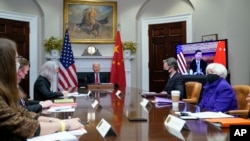A Sino-U.S. military dialogue that coincided with a defense budget increase this month reveal a key piece of President Joe Biden’s China policy—talk and prepare to fight all at once—analysts believe.
The U.S. Senate voted Wednesday for a version of the National Defense Authorization Act (NDAA) that authorizes $770 billion in defense spending, $25 billion more than Biden requested and including $7.1 billion for the Pacific Deterrence Initiative aimed at checking Chinese expansion.
And from Tuesday through Thursday, representatives from U.S. Indo-Pacific Command, navy and air force met virtually with counterparts from the Chinese People’s Liberation Army’s navy and air force for talks on staying safe in Asia’s contested waterways.
“U.S. military, they do what they have to do, like conduct Freedom of Navigation operations in the South China Sea, but they also make sure there are guardrails, they continue to keep the lines of communication open with the Chinese,” said Aaron Rabena, research fellow at the Asia-Pacific Pathways to Progress Foundation in Metro Manila.
Washington increased in 2019 the number of warship passages through the South China Sea to 10 per year, a number that it repeated in 2020. U.S. officials describe the passages as “Freedom of Navigation operations.”
China and the United States are in what scholars describe as a “great power competition,” with Washington particularly targeting the other side’s expansion in the East and South China seas where the U.S. counts nearby countries as geopolitical allies. Biden will carry on the competition but hopes to stop any violent flareups, analysts say.
Negotiate while bolstering defense
The version of the NDAA bill passed Wednesday included a statement of congressional support for the defense of Taiwan and a ban on any Defense Department procurement of goods produced with forced labor from China's restive and largely Muslim Xinjiang region. The act now requires Biden’s signature.
The military talks, a process that began in 1998, were held to reduce risks and improve “operational safety” in the air and sea, the U.S. Indo-Pacific Command said in a statement. U.S. and Chinese officials discussed this time upholding “professionalism” and reviewed “safety-related events,” the Friday statement says.
China calls the 3.5 million-square-kilometer, resource-rich South China Sea its own, clashing with the claims of militarily weaker Brunei, Malaysia, the Philippines, Taiwan and Vietnam. U.S. warships also sail the Taiwan Strait, a warning against China not to attack the self-ruled island, which China claims as its own.
Crisis management, such as “ship-to-ship protocol” and working hotlines, is the U.S. military’s top priority for China, said Gregory Poling, director of the Asia Maritime Transparency Initiative under the Washington-based Center for Strategic and International Studies.
“It’s OK to have tensions in the diplomatic arena and even the economic arena, but nobody wants it to move out of the so-called grey zone into open conflict,” Poling said.
Two-pronged China strategy
Biden indicated that talks are part of his policy in mid-November by taking part in his first voice-to-voice chat with Chinese President Xi Jinping after a senior-level dialogue broke down in the later part of ex-president Donald Trump’s term. Analysts considered that event a groundbreaker that could slowly lead to talks on headier issues that have hobbled Sino-U.S. ties since 2017 over trade, consular affairs and geopolitical differences.
The U.S. president “underscored the importance of managing strategic risks” in his comments to Xi, but at the same time underscored the United States will continue to stand up for its interests and values,” according to a White House statement.
Biden is seeking a “managed competition with China,” Rabena said.
Success of last week’s military talks may hinge on what comes next, scholars believe. If the U.S. government pulls back on Freedom of Navigation exercises and military engagement with Taiwan, for example, Beijing and Washington may have reached “consensus” at the December 14-16 talks, Rabena said.
Follow-up talks and eventual “confidence building measures” would indicate the Biden-Xi chat made an impact, said Collin Koh, a maritime security research fellow at Nanyang Technological University in Singapore.
But Washington’s Pacific Deterrence Initiative [PDF] calls China “the number one pacing challenge” for U.S. forces and says the 2022 budget “will be used to develop and procure defense capabilities in support of joint force lethality, especially in providing survivable strike and stand-off capability in a denied environment,” according to a mid-2021 Department of Defense statement.
“Given that there are still pressing issues that continue to bedevil bilateral ties, I believe both the Chinese and the Americans probably felt [it] necessary to continue dialogue at this level,” Koh said.
Chinese state-run media have kept quiet on the U.S.-China talks this week, but the Chinese Communist Party owned China Daily news website a year ago blasted the Pacific Deterrence Initiative as being a cost to other Asian countries rather than a “strong signal to China.”










